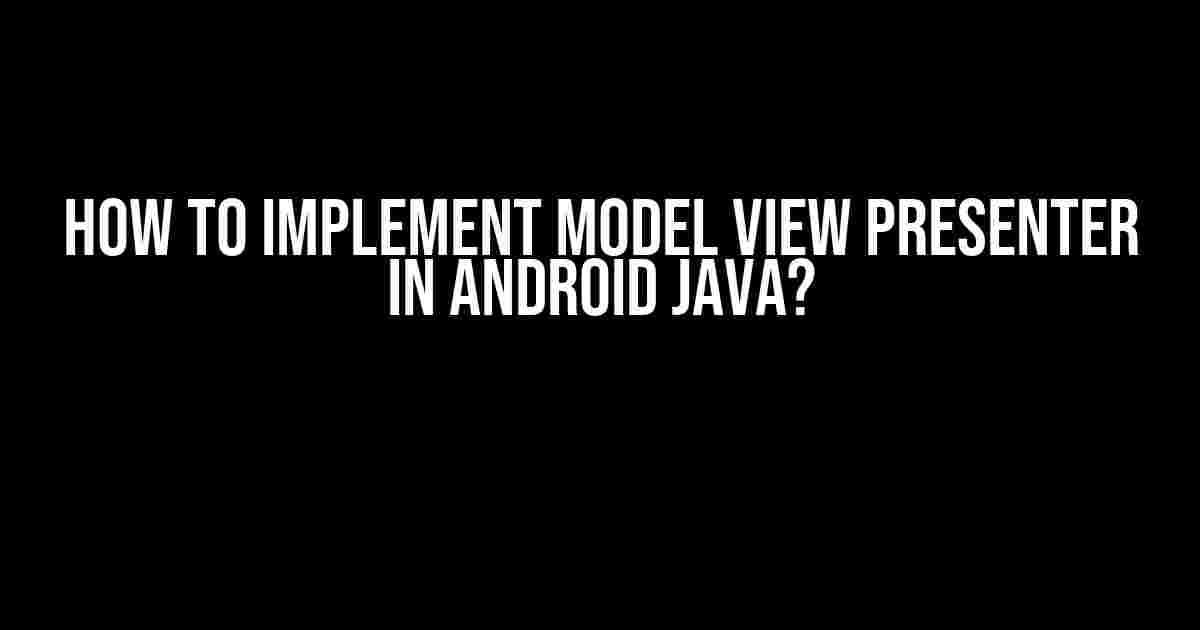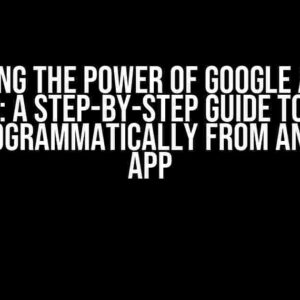Welcome to the world of MVP! Are you tired of spaghetti code in your Android app? Do you want to separate concerns and make your life easier? Look no further! In this article, we’ll guide you through the process of implementing Model-View-Presenter (MVP) architecture in Android using Java.
What is MVP?
MVP is an architectural pattern that separates an application into three interconnected components: Model, View, and Presenter. This separation of concerns makes it easier to maintain, test, and extend your app.
Here’s a brief overview of each component:
- Model: Represents the data and business logic of the application. It’s responsible for storing, retrieving, and manipulating data.
- View: Responsible for rendering the user interface and displaying data to the user.
- Presenter: Acts as an intermediary between the Model and View, handling user input, and updating the View accordingly.
Why Use MVP in Android?
MVP brings several benefits to your Android app, including:
- Separation of Concerns: Each component has a clear, defined role, making it easier to maintain and extend your app.
- Easier Testing: With MVP, you can test each component independently, reducing the complexity of your tests.
- Improved Code Organization: MVP encourages a more structured approach to coding, leading to cleaner and more readable code.
Implementing MVP in Android Java
Now that we’ve covered the basics, let’s dive into the implementation details. We’ll create a simple todo list app using MVP architecture.
Step 1: Create the Model
The Model represents the data and business logic of our app. Create a new Java class called `TodoItem`:
public class TodoItem {
private String title;
private boolean completed;
// getters and setters
}
Create another class called `TodoRepository` to store and retrieve todo items:
public class TodoRepository {
private List<TodoItem> todoItems = new ArrayList<>();
public List<TodoItem> getTodoItems() {
return todoItems;
}
public void addTodoItem(TodoItem todoItem) {
todoItems.add(todoItem);
}
public void removeTodoItem(TodoItem todoItem) {
todoItems.remove(todoItem);
}
}
Step 2: Create the View
The View is responsible for rendering the user interface. Create a new Java class called `TodoActivity`:
public class TodoActivity extends AppCompatActivity {
private RecyclerView recyclerView;
private TodoAdapter adapter;
@Override
protected void onCreate(Bundle savedInstanceState) {
super.onCreate(savedInstanceState);
setContentView(R.layout.activity_todo);
recyclerView = findViewById(R.id.recycler_view);
recyclerView.setLayoutManager(new LinearLayoutManager(this));
adapter = new TodoAdapter();
recyclerView.setAdapter(adapter);
}
}
Create a new layout file called `activity_todo.xml`:
<?xml version="1.0" encoding="utf-8"?>
<LinearLayout xmlns:android="http://schemas.android.com/apk/res/android"
xmlns:app="http://schemas.android.com/apk/res-auto"
android:layout_width="match_parent"
android:layout_height="match_parent"
android:orientation="vertical">
<androidx.recyclerview.widget.RecyclerView
android:id="@+id/recycler_view"
android:layout_width="match_parent"
android:layout_height="match_parent">
</androidx.recyclerview.widget.RecyclerView>
</LinearLayout>
Step 3: Create the Presenter
The Presenter acts as an intermediary between the Model and View. Create a new Java class called `TodoPresenter`:
public class TodoPresenter {
private TodoRepository repository;
private TodoActivity view;
public TodoPresenter(TodoRepository repository, TodoActivity view) {
this.repository = repository;
this.view = view;
}
public void loadTodoItems() {
List<TodoItem> todoItems = repository.getTodoItems();
view.showTodoItems(todoItems);
}
public void addTodoItem(String title) {
TodoItem todoItem = new TodoItem(title, false);
repository.addTodoItem(todoItem);
view.showTodoItems(repository.getTodoItems());
}
public void removeTodoItem(TodoItem todoItem) {
repository.removeTodoItem(todoItem);
view.showTodoItems(repository.getTodoItems());
}
}
Step 4: Connect the Components
Now that we have all the components, let’s connect them. Update the `TodoActivity` class:
public class TodoActivity extends AppCompatActivity {
private RecyclerView recyclerView;
private TodoAdapter adapter;
private TodoPresenter presenter;
@Override
protected void onCreate(Bundle savedInstanceState) {
super.onCreate(savedInstanceState);
setContentView(R.layout.activity_todo);
recyclerView = findViewById(R.id.recycler_view);
recyclerView.setLayoutManager(new LinearLayoutManager(this));
adapter = new TodoAdapter();
recyclerView.setAdapter(adapter);
TodoRepository repository = new TodoRepository();
presenter = new TodoPresenter(repository, this);
presenter.loadTodoItems();
}
public void showTodoItems(List<TodoItem> todoItems) {
adapter.setTodoItems(todoItems);
adapter.notifyDataSetChanged();
}
}
That’s it! You’ve successfully implemented Model-View-Presenter architecture in your Android app using Java.
Best Practices and Common Pitfalls
When implementing MVP, keep the following best practices in mind:
- Keep the Presenter thin: Avoid putting too much logic in the Presenter. It should only handle user input and update the View accordingly.
- Use a single source of truth: The Model should be the single source of truth for your app’s data. Avoid duplicating data in the View or Presenter.
- Keep the View passive: The View should only render the data provided by the Presenter. Avoid putting business logic in the View.
Common pitfalls to avoid:
- Tightly coupled components: Avoid tight coupling between components. Use interfaces and dependency injection to keep them loosely coupled.
- Presenter doing too much: Avoid putting too much logic in the Presenter. It should only handle user input and update the View accordingly.
- Model not being used: Make sure to use the Model as the single source of truth for your app’s data.
| Component | Responsibilities |
|---|---|
| Model | Data storage and business logic |
| View | User interface and data rendering |
| Presenter | User input handling and View updating |
By following these guidelines and avoiding common pitfalls, you’ll be well on your way to creating a maintainable and scalable Android app using MVP architecture.
Conclusion
In this article, we’ve covered the basics of MVP architecture and implemented it in a simple Android app using Java. By separating concerns and using a structured approach, you can create more maintainable and scalable code. Remember to keep the Presenter thin, use a single source of truth, and avoid tightly coupled components. Happy coding!
Do you have any questions or need further clarification on any of the steps? Leave a comment below!
Frequently Asked Question
Get ready to elevate your Android app development skills with Model-View-Presenter (MVP) architecture!
What is the main purpose of the Presenter in MVP architecture?
The Presenter acts as an intermediary between the View and the Model, retrieving data from the Model and formatting it for display on the View. It also receives input from the View and performs any necessary actions, such as retrieving data or performing calculations.
How do I implement the View in MVP architecture?
The View is typically an Android Activity or Fragment that displays data to the user. You should define an interface for the View that specifies the methods the Presenter can call to update the display. The View should not contain any business logic and should only be responsible for displaying data and receiving user input.
What is the role of the Model in MVP architecture?
The Model represents the data and business logic of the application. It provides access to the data and performs any necessary calculations or operations on that data. The Model should be independent of the View and Presenter, allowing it to be easily replaced or modified without affecting the rest of the application.
How do I handle user input in MVP architecture?
When the user interacts with the View, the View should notify the Presenter of the input. The Presenter can then use the Model to perform any necessary actions or retrieve data. The Presenter can then update the View with the results, ensuring that the View remains up-to-date and accurate.
What are the benefits of using MVP architecture in Android app development?
MVP architecture provides a clear separation of concerns, making it easier to maintain and modify the application. It also reduces coupling between components, allowing for more modular and reusable code. Additionally, it improves testability and facilitates the use of unit tests and integration tests.


